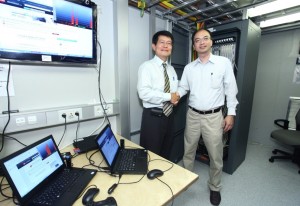TCP (Transmission Control Protocol) is essential for data transmissions through networks, no matter the transmission is through mobile phone or computer. TCP was originally designed for wired networks, which have transmission properties different from those of wireless networks, it does not perform well in wireless networks like mobile or satellite networks. The network capacity is severely underutilized and the actual transmission performance may be as low as 10% of the specified maximum.
To solve the above problem, Professor Jack Lee (right in photo), Associate Professor of the Department of Information Engineering in the Chinese University of Hong Kong (CUHK), has started a research on a traffic accelerator for mobile networks since 2009. His invention enables TCP to fully utilize the underlying network bandwidth and thus speed up the transmission without any modification to the web servers or the hardware/software of the mobile phones. It does not require extra memory resources from the mobile phones. The solution resides only in a box sitting somewhere between the server and the client like a proxy. It has been proved that transmissions through 3G mobile networks can be accelerated to one to five times of the original speed. Besides, the invention can work on any operating systems and is compatible with all existing applications like web browsers, ftp, email and p2p software.
Recently, CUHK and Nokia Siemens Networks performed a preliminary test on the accelerator on the latest LTE 4G mobile networks. The result is very promising that the data speed was accelerated for more than three times when downloading photos or HD videos with the accelerator.
Professor Jack Lee said, “Many Hong Kong people love to go online anytime anywhere. They watch videos and download photos from the Internet and that requires high transmission speed. The accelerator just overcomes the intrinsic limitations of TCP and substantially increases the effective transmission rate. Together with the latest 4G mobile technology, users may enjoy much faster and smoother networks in the future.”


 Contact Us
Contact Us

